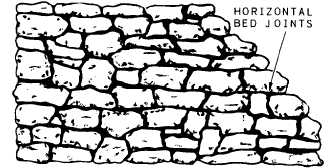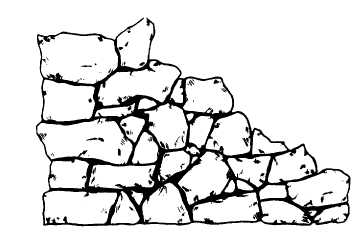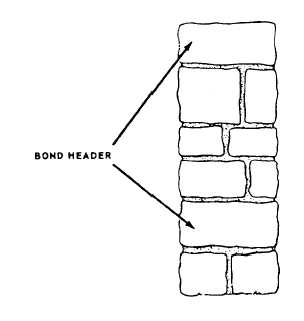Figure 7-47.-Random rubble stone masonry.
Figure 7-48.-Layers of bond stones in random stone
masonry.
stones in courses, as shown in figure 7-47. Each
layer must contain bonding stones that extend
through the wall, as shown in figure 7-48. This
produces a wall that is well tied together. The bed
joints should be horizontal for stability, but the
“builds” or head joints may run in any direction.
Coursed rubble consists of roughly squared
stones assembled in such a manner as to produce
approximately continuous horizontal bed joints,
as shown in figure 7-49.
The stone for use in stone masonry should be
strong, durable, and cheap. Durability and
strength depend upon the chemical composition
and physical structure of the stone. Some of the
Figure 7-49.-Coursed rubble masonry.
more commonly found stones that are suitable are
limestone, sandstone, granite, and slate. Un-
squared stones obtained from nearby ledges or
quarries or even fieldstone maybe used. The size
of the stone should be such that two people can
easily handle it. A variety of sizes is necessary to
avoid using large quantities of mortar.
The mortar for use in stone masonry may be
composed of portland cement and sand in the
proportions of one part cement to three parts sand
by volume. Such mortar shrinks excessively and
does not work well with the trowel. A better
mortar to use is portland cement-lime mortar.
Mortar made with ordinary portland cement will
stain most types of stone. If staining must be
prevented, nonstaining white portland cement
should be used in making the mortar. Lime does
not usually stain the stone.
BRICK MASONRY
In brick masonry construction, units of baked
clay or shale of uniform size are laid in courses
with mortar joints to form walls of virtually
unlimited length and height. These units are small
enough to be placed with one hand. Bricks are
kiln-baked from various clay and shale mixtures.
The chemical and physical characteristics of the
ingredients vary considerably; these and the kiln
temperatures combine to produce brick in a
variety of colors and harnesses. In some regions,
pits are opened and found to yield clay or shale
that, when ground and moistened, can be
formed and baked into durable brick; in other
regions, clays or shales from several pits must be
mixed.
The dimensions of a U.S. standard building
brick are 2 1/4 by 3 3/4 by 8. The actual
dimensions of brick may vary a little because of
shrinkage during burning.
7-30





